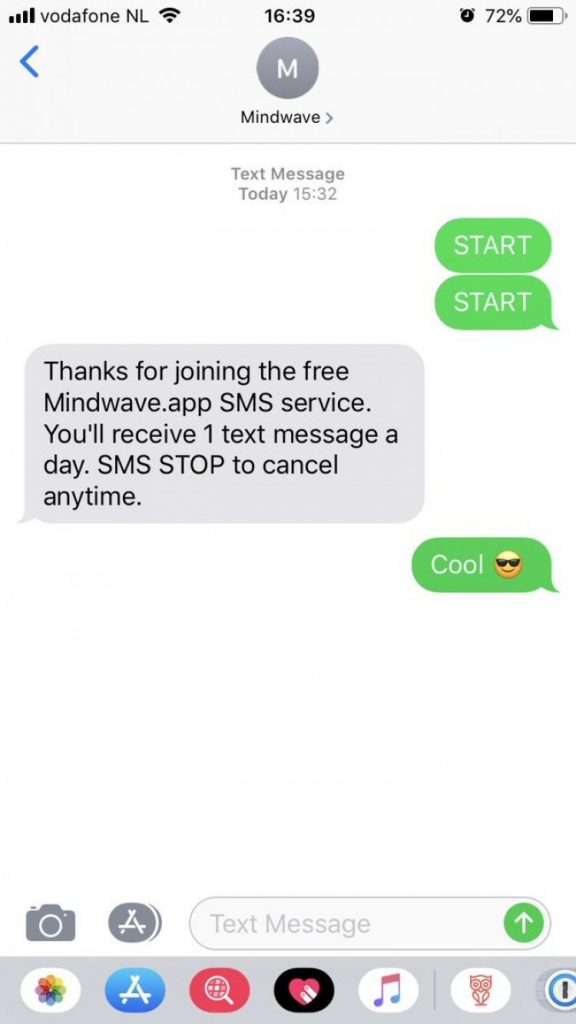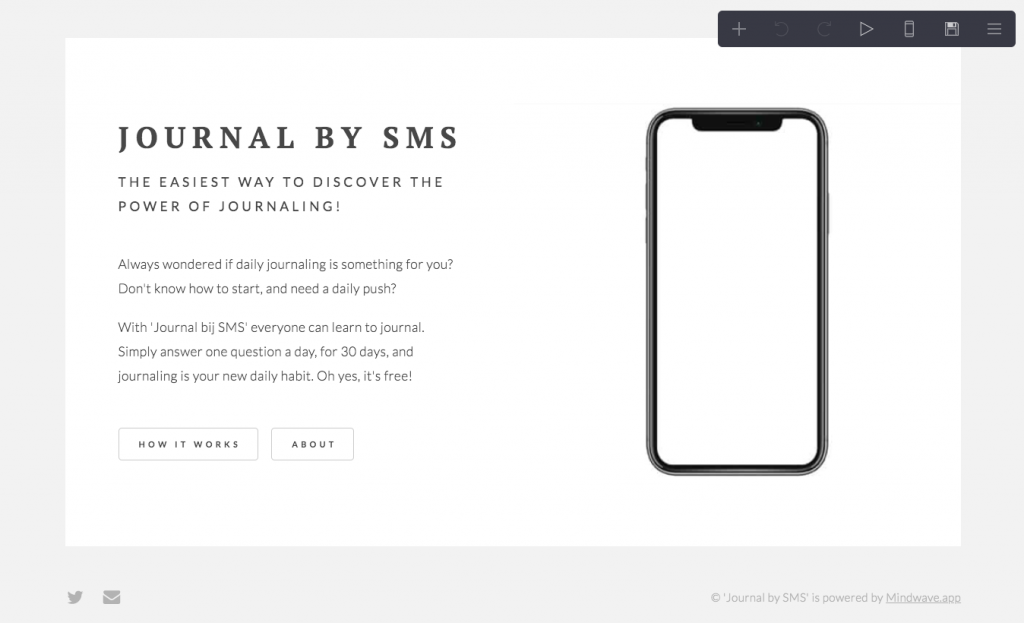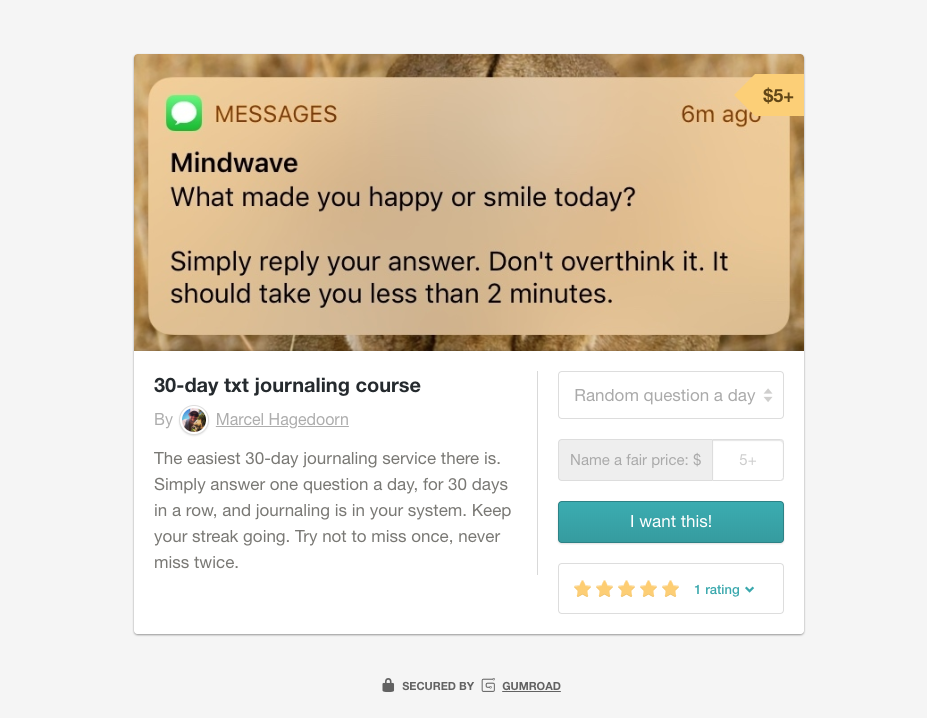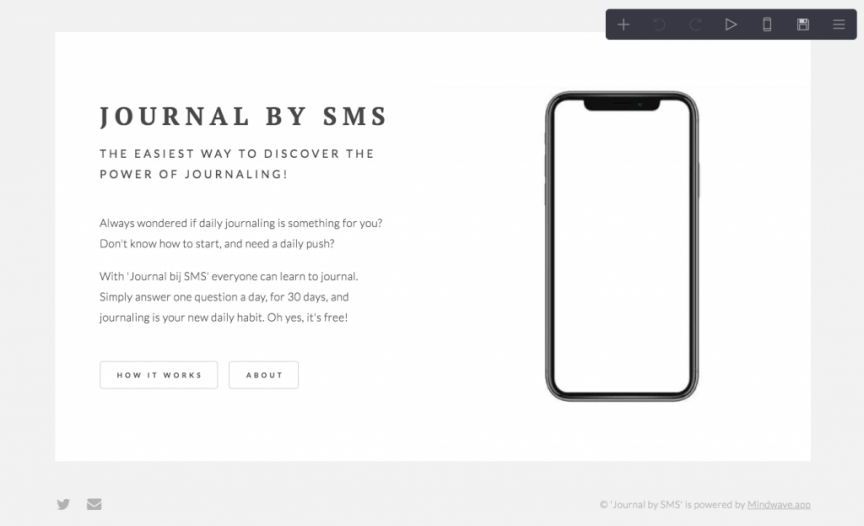One of the features I want to implement in Mindwave is a ‘learn to journal’ course. Journaling is so easy to do, it only takes 2 minutes a day. But to get it in your daily system is actually quite hard.
How can I help founders & makers who want to learn how to journal in the easiest way? And learn how to build a course at the same time? Time for an experiment!
Journal by text messages
What if, the only thing people really need is a daily push! Journaling is al about doing. All you need is a 30-day streak to adopt a new habit. So maybe the push is the only thing people need to actually learn to journal?
Can I build something in Telegram? Yes, I’ve done that before.
Can I build notifications via Email? Yes, that’s already implemented in Mindwave.
Can I build mobile notifications for the mobile website? Yes, that’s on the feature list.
But what if we use SMS instead. Something everyone is familiar with. No app needed, no mobile website needed, no account needed, and no credit card needed.
Could this be the way to build a journaling course, without me writing any code?
My maker mood is on, let’s try and discover along the way.
Step 1 – MessageBird
I created an account in MessageBird, singed up for a virtual mobile number and made an SMS-flow. Run a test and BAM, it worked.

Step 2 – Make a website
Then I used carrd.co to make a small website. Creating a website helps me to make this idea reality. Form mind to site. Thinking about headers, about content, about how it works. It makes it all very concrete. I like that process, it challenges me to think in solutions.
The first mockups:

The website isn’t live somewhere. Don’t want people to test this service without me being ready for it 😉
Step 3 – TXTjournaling .com
I registered txtjournaling.com for this ‘powered by Mindwave’ experiment. Or should I go for another domain? ?? Does the domain matter atm? No, stick to it!
Step 4 -Simple calculation of costs
Quick math: Sending an SMS via MessageBird will cost me € 0,076 a message. So, it will cost about € 2,35 per subscriber per course.
Step 5 – Give it some thought
I’ve done some cool steps to make this experiment reality. Maybe take a moment to collect this process in Mindwave and give it some thought over the next days. If I’m still enthusiastic about the experiment, proceed!
Step 6 – Issue! What about timezones?
Oh, Timezones! There is an option to schedule an SMS, but no (automatic) timezones here. So 20:00 pm in the Netherlands would be 11:00 am in Los Angeles or 02:00 am in Singapore.
Ther is an option to do Bulk SMS. I can make an .xls file with the messages and schedule them at a specific time. This way I could calculate the exact time, using the mobile phones country code. But, then I would create all text messages upfront. And an opt-out would mean manually deleting all messages in the queue. Manual error alert!

At the same time, I want to keep my no-code challenge alive. Build this without any coding. Using an API would be a perfect solution if you’re a developer. But that’s not me. So, think harder. Check again.
Step 7 – Three different timezone courses
My solution, for now, is to create 3 different courses. One for the US, one for Eu and one for Asia. This doesn’t solve all timezone issues. But creating 24 courses isn’t a solution either.
So I changed the flow builder using START EU, START US and START ASIA to opt-in to the course.
Next to the 3 different zones, I also connected the groups to a specific month. So if you opt-in in July, your course starts on August 1st. But if you opt-in on August 2th, your course starts on September 1th. Different groups, to make sure the course stops after 30 days. plus, STOP will mean instantly deleting the contact and stop all communication. No matter which group (month or timezone) someone is in.
Step 8 – What questions to ask?
When building a habit the process is most important. Build a streak. Try not to miss once. Never miss twice. Something I learned from the book Atomic Habits (read my book notes here).
So, does it really matter what question to ask? My Mindwave users think so! And since participants can’t choose for a specific topic (maybe something for the future, a 30-day gratefulness course?) I will surprise them with a random daily question.
I probably have a thing for surprises ?
Step 9 – Re-do step 7
I had to re-think and re-do step 6. Working with the 3 timezones isn’t that great. The course would be a lot better if the participant:
- can choose his own receiving time;
- can select his own time zone;
- can start the next day.
So I changed the entire setup. From messaging a course group to individual text messages. Every new participant will get his own course. So this means a bit more manual work. For now, to keep the ‘no code challenge’ alive. But in the end, this solution is also more future proof.
I can totally imagine someone buying a ‘gratefulness journaling course’, and for the next 30-days the message ‘What are you grateful for?’ will be sent to the customer. Easy to automate.
Step 10 – Integrate Gumroad before launching publicly
In step 6 I calculated the costs for every participant. In other words, every participant will cost me if I don’t make the course a paid one. So, why not go for a paid course from the start. Especially when there are great reasons to go for paid anyway, such as:
- If you pay for something, you have more skin in the game;
- The business model is the message. I want to create value with the service, not with the user’s data;
- Product validation;
- Build a profitable, sustainable course from the start.
So first I created a Gumroad account. Gumroad is an e-commerce platform for creators. A simple way to sell products and build an audience. Plus, the founder has an awesome story.
Then I created two (paid) products:
- 30-day journaling course.
The price for the course isn’t fixed. So what is a calm and clear mind worth to participants?
Also, participants have the option to go for a random question a day, or to select a daily question (eg. What are you grateful for today?). - TXT journaling subscription.
A monthly subscription for daily txt journaling. This is an experiment to reach other target groups and make the course available for everyone. Different from Mindwave’s founders & makers focus.
And then I integrated the products on the website with this strategy:
Offer a free 7-day trial and then, after 7 days, ask to purchase a course or upgrade to a subscription. Next to the free trial, there is an option to go for these products from the start. Using text links instead of the start your free trial call-to-action.
The Gumroad product & check-out looks like:

Step 11 – Invite my first (beta) participants
I invited some beta users to test the course, and the website. And made some cool improvements with their feedback. For example: prefill the text message ppl need to send (via @dannypostma).
I used Twitter and Mailchimp for the first batch. Later this month: LinkedIn and ProductHunt.
Then maybe experiment with Google Ads ??
Step 12 – Reflect
While writing the Mailchimp newsletter my mind started to reflect. That’s the power of writing! But the reflections weren’t suitable for the newsletter. That needed to be to clear and to the point.
So I’m going to write down the reflections here. That’s what Mindwave is for, right?
NoCode
I challenge myself to build TXT journaling without writing any code. In general that’s not a problem. I don’t know how to code! But can I create a valuable product without any code, and join the nocode movement?
Text messaging
Next to the course, I think text messages (SMS) can be a great tool for Mindwave as well. Most people use Whatsapp and Telegram these days. So maybe receiving text messages can be an opportunity. To program messaging in the participant’s brain as ‘the place to journal’. Maybe add text as notification option as well.
Multi app strategy
What if users can choose their own app to journal, but always know their data is synced/pushed to Mindwave.app? Wouldn’t it be great to choose your own tool to journal?
- Via the web browser (desktop and mobile);
- Via text messaging;
- Via the (future) Mindwave app;
- Via a MindwaveBot in telegram;
- Maybe even via email, like Evernote does?
Make them all work and push the data to Mindwave as the go-to place to reflect on the thoughts.
Story updated 13 August ’19 …to be continued

